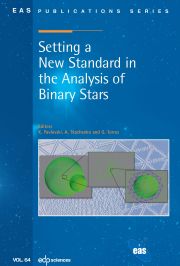No CrossRef data available.
Article contents
Mass Loss from Betelgeuse
Published online by Cambridge University Press: 23 May 2013
Abstract
Betelgeuse is just starting to produce a wind which is thick enough to form dust. However, the grains seem to coalesce at much greater distances than those in “dust-driven” winds from later-stage AGB and RSG stars. Is the mass loss mechanism different, and how will it evolve? We know a great deal about the kinematics of the more evolved winds, thanks to sub-au imaging using masers, and easily-resolved CO shells, but Betelgeuse is a much fainter target, only resolved with great difficulty (although ALMA will change that). On the other hand, Betelgeuse was the first star other than the Sun to be imaged in detail in the radio as well as optical. Radio studies from the photosphere to the astropause will reveal: How is mass lost from the stellar surface? In what form is this returned to the ISM? These results could even help to answer: How will Betelgeuse evolve in the next few millennia?
- Type
- Research Article
- Information
- Copyright
- © EAS, EDP Sciences 2013


